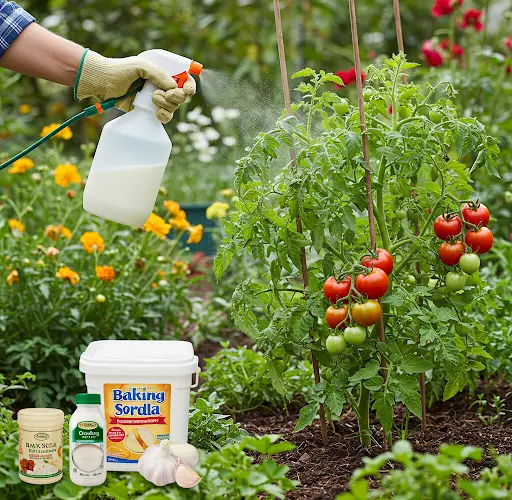Natural Methods for Preventing and Treating Late Blight in Tomatoes
Late blight (Phytophthora infestans) is a devastating fungal disease that affects tomatoes, often leading to severe yield loss if left untreated. The disease spreads rapidly under favorable conditions, particularly in humid and rainy weather. To protect tomato plants from late blight, various natural remedies can be used, including baking soda, milk, garlic, and horsetail (Equisetum arvense). These environmentally friendly solutions are safe for organic gardening and can help prevent or manage the disease without resorting to synthetic fungicides.
Understanding Late Blight
Late blight is most active during the summer months when warm, wet conditions allow the fungus to thrive. It can quickly destroy an entire crop, either partially or completely. The severity of the outbreak depends on climatic conditions and the tomato variety chosen. However, regardless of these factors, gardeners must be prepared to take preventive action.
The first visible symptoms of late blight include yellowing and drying of the lower leaves, especially at the tips. If left untreated, the disease spreads to other leaves, stems, and even fruit, significantly reducing yield and affecting the overall health of the plant. Early detection is crucial to controlling the disease and preventing further spread.
To mitigate the effects of late blight, tomato plants should be sprayed regularly throughout the growing season, beginning from the flowering stage. The natural treatments outlined below are effective against late blight and are safe to use in organic farming.
Baking Soda Spray for Late Blight Prevention
Baking soda is an excellent alkaline agent that helps prevent the growth of fungal diseases like late blight. It alters the pH level on the surface of the plant, creating an environment unsuitable for fungal development. Since baking soda is readily available and has multiple household uses, it is a convenient option for organic gardeners.
To prepare a baking soda spray for tomatoes:
- Dissolve 50 grams of baking soda in 10 liters of water.
- Pour the solution into a sprayer and mix well.
- Spray the tomato plants thoroughly, covering both sides of the leaves, the stems, and surrounding soil.
For preventive care, apply the baking soda spray once a week. If late blight symptoms appear, remove affected leaves and spray the plants more frequently to halt disease progression.
Milk Spray as a Natural Fungicide
It may seem surprising, but milk has proven to be effective in preventing and controlling fungal diseases, including late blight. It works differently from baking soda and can be used in combination for a more comprehensive approach to disease management. The proteins in milk have antifungal properties, and when exposed to sunlight, they release compounds that help suppress fungal growth.
To make a milk spray:
- Mix 1 liter of cow’s or goat’s milk with 10 liters of water.
- Stir the solution well and pour it into a sprayer.
- Spray the entire plant, ensuring thorough coverage.
Milk spray should be applied once a week for disease prevention. If combined with baking soda, alternate applications to enhance protection.
Garlic Spray for Natural Disease Control
Garlic is widely recognized for its antifungal and antimicrobial properties, making it an excellent natural remedy against plant diseases, including late blight. Its sulfur compounds help suppress fungal growth and can be used preventively or as a treatment when symptoms appear.
To prepare a garlic spray:
- Crush or finely chop 50 grams of garlic.
- Soak the garlic in 10 liters of water overnight.
- Strain the mixture and pour it into a spray bottle.
- Apply to tomato plants every two weeks for preventive care or more frequently (after every rain) if late blight is present.
This solution can also be used on other crops susceptible to fungal infections.
Horsetail Spray for Strengthening Tomato Plants
Horsetail (Equisetum arvense) is another effective natural remedy for preventing late blight. This plant is rich in silicon, which strengthens plant cell walls and helps resist fungal infections. In addition to late blight, horsetail spray is beneficial against other fungal diseases affecting tomatoes and other garden plants.
To prepare a horsetail spray:
- Gather fresh or dried horsetail leaves.
- Boil the leaves in water for about 30 minutes.
- Allow the mixture to cool before diluting it with 10 liters of water.
- Pour the solution into a sprayer and apply it to tomato plants.
For best results, use horsetail spray preventively and after the first signs of disease.
Additional Preventive Measures Against Late Blight
While these natural remedies can significantly reduce the risk of late blight, it is also important to practice good cultural and preventive measures to enhance plant resilience. Some key strategies include:
- Choosing resistant varieties: Some tomato cultivars are naturally more resistant to late blight.
- Proper spacing: Ensure adequate spacing between plants to improve airflow and reduce humidity levels.
- Watering at the base: Avoid overhead watering, as wet leaves encourage fungal growth. Drip irrigation is ideal.
- Mulching: Apply mulch around the base of plants to reduce soil splash, which can spread fungal spores.
- Removing affected plant parts: At the first sign of late blight, remove and dispose of infected leaves to prevent further spread.
Conclusion
Late blight is a serious threat to tomato crops, but with proactive and natural approaches, it can be managed effectively. Baking soda, milk, garlic, and horsetail sprays offer environmentally friendly solutions for preventing and treating this fungal disease. By incorporating these organic treatments into regular plant care routines, gardeners can maintain healthier tomato plants and enjoy a more successful harvest. Combined with good cultural practices, these natural remedies provide a sustainable and effective way to combat late blight without relying on chemical fungicides.



